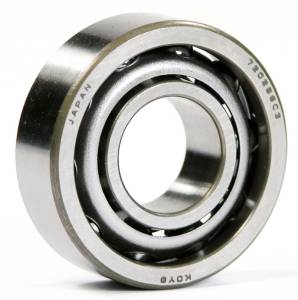Description
Angular Contact Ball Bearings: Precision and Performance for High-Speed Applications
Angular contact ball bearings are high-precision rolling element bearings designed to handle significant axial loads in one direction, along with moderate radial loads. Unlike deep groove ball bearings, their unique contact angle allows them to effectively manage combined loads, making them ideal for applications requiring high speeds and precision.
Key Features & Benefits:
- High Load Capacity: The angled contact between the balls and raceways allows for efficient load distribution, providing superior load-carrying capacity, particularly in axial directions. The exact capacity depends on the bearing's size, material, and design specifications.
- High Speed Capability: Optimized geometry and precise manufacturing minimize friction, enabling these bearings to operate at significantly higher speeds than other bearing types. Their inherent stiffness also contributes to stable high-speed performance.
- Directional Axial Load Handling: The inherent design efficiently accommodates axial loads in a specific direction (either internal or external). For bi-directional axial load applications, duplex bearing arrangements (paired bearings) are commonly employed.
- High Precision & Accuracy: Angular contact bearings are manufactured to tight tolerances, ensuring superior accuracy and smooth operation. This precision is critical in applications where positional accuracy and minimal vibration are paramount.
- Variety of Sizes and Configurations: Available in a wide range of sizes and configurations to meet diverse application needs. Options include single-row, double-row (duplex), and even specialized designs for specific applications.
- Material Options: Typically made from high-quality bearing steel, but other materials may be used depending on the application's requirements (e.g., stainless steel for corrosive environments).
Applications:
Angular contact ball bearings find applications in a diverse range of industries and equipment, including:
- High-speed machinery: Turbines, spindles, machine tools, and precision instruments.
- Automotive components: Wheel hubs, transmissions, and other rotating parts.
- Aerospace applications: Gyroscopes, actuators, and flight control systems.
- Robotics: Articulated joints and robotic arms.
- Medical equipment: Precision instruments and surgical tools.
Specifications (General - Specifics vary depending on the model):
- Bore Diameter: Ranges from millimeters to inches, depending on the bearing's size.
- Outside Diameter: Dependent on the bore diameter and bearing series.
- Width: The axial dimension of the bearing.
- Contact Angle: A key design parameter influencing load capacity and axial load direction.
- Basic Dynamic Load Rating (C): A measure of the bearing's capacity for dynamic loads.
- Basic Static Load Rating (C0): A measure of the bearing's capacity for static loads.
Selecting the Right Angular Contact Bearing:
Proper selection requires careful consideration of factors such as load requirements (radial and axial), operating speed, required accuracy, environmental conditions, and available space. Consult engineering specifications and manufacturer's catalogs for detailed selection guidance.
Note: This is a general description. Specific characteristics vary widely depending on the manufacturer, size, and design of the angular contact bearing. Always consult the manufacturer's documentation for precise specifications and application recommendations.
